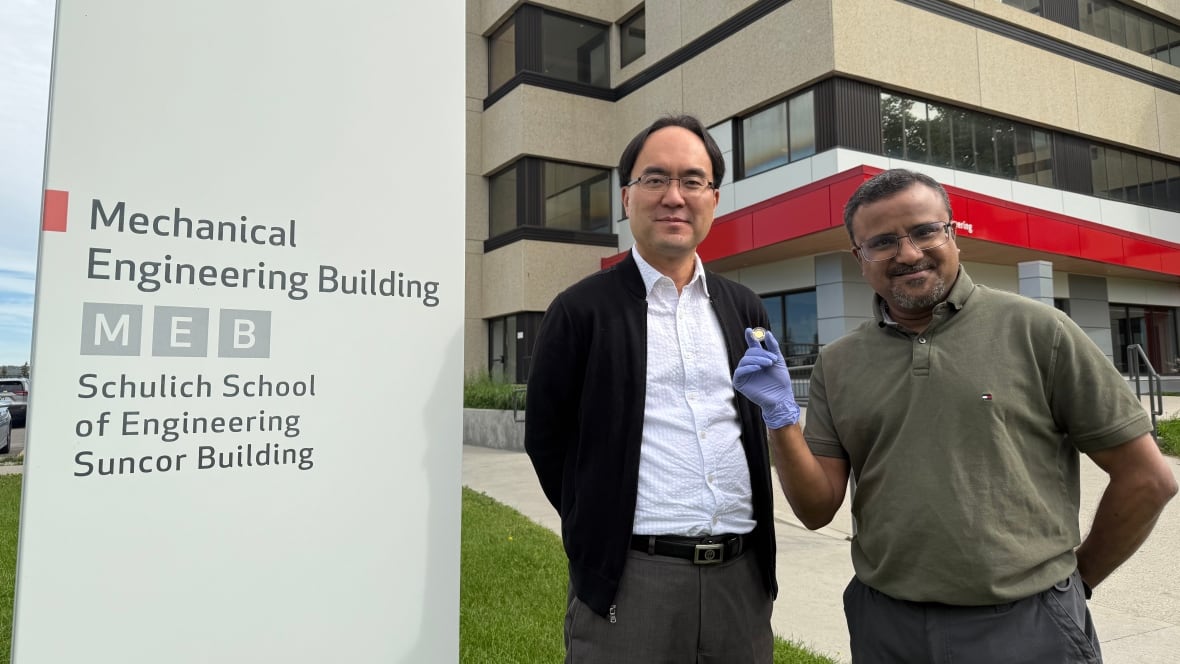Science
Calgary Researchers Create Innovative Airborne Molecule Sensors

Researchers at the University of Calgary have developed a groundbreaking sensor capable of detecting airborne molecules at concentrations as low as 100 parts per billion. This innovation, inspired by the scent-tracking abilities of insects, represents a significant advancement in chemical sensing technology. The findings were detailed in a recent study published in the journal Nano Letters.
The sensor’s design mimics the natural behavior of insects, such as fruit flies, which are adept at locating higher concentrations of scent. According to Arindam Phani, a research associate at the university, the sensor operates on the principle that as insects fly, they seek out areas with increasing scent concentration. This technology allows the sensor to detect organic compounds in the air with remarkable sensitivity.
Sam Kim, a professor at the Schulich School of Engineering and co-author of the study, emphasized the challenges in creating a sensor that is both “sensitive” and “selective.” The new device, which features a vibrating quartz crystal coated in a thin layer of a porous material known as a metal-organic framework, can differentiate between various gases, overcoming a common limitation in traditional sensors.
Potential Applications in Health and Environmental Monitoring
Phani envisions several applications for this innovative technology, particularly in the realm of health care. The sensor could enhance breath analysis, potentially aiding in the early detection of diseases such as cancer and diabetes. “Our breath contains a wealth of information,” Phani stated, noting that it consists of hundreds of low-concentration molecules. By achieving sensitivity at parts per billion, the sensor could pioneer a new generation of breath analysis techniques, surpassing conventional breathalyzer tests.
The capacity to detect specific biomarker compounds in breath is critical. Phani stated, “If you can give us a very clear biomarker from our breath, definitely, we can develop a sensor for that and we can target it.” This focus on health monitoring reflects a growing trend towards non-invasive diagnostic methods.
Another significant application for the sensor lies in environmental monitoring, specifically in early forest fire detection. Phani explained that gases like nitrogen oxides, which are present in low concentrations at the onset of a fire, could be identified using this technology. “There is a possibility we can design sensors specifically catered for forest fire detection. If you can do it quickly when the forest fire starts… it will be much easier to control.”
Future Developments and Cost Efficiency
The research team is optimistic about the future of their sensor technology. Phani mentioned that integrating the sensor onto drones could facilitate the creation of 3D concentration maps, useful for monitoring gas leaks along pipelines or detecting environmental hazards.
Currently, the production cost of a basic sensor is around $25, with prices varying based on complexity and function. Phani expressed confidence that scaling up production could further reduce costs, making this technology more accessible for widespread use.
As research continues, the potential for this sensor technology to revolutionize health diagnostics and environmental monitoring remains promising. With ongoing collaboration between engineers and health professionals, the application of this innovative sensing technology is poised to expand, ultimately enhancing public health and safety.
-

 Science2 months ago
Science2 months agoToyoake City Proposes Daily Two-Hour Smartphone Use Limit
-

 Health2 months ago
Health2 months agoB.C. Review Reveals Urgent Need for Rare-Disease Drug Reforms
-

 Top Stories2 months ago
Top Stories2 months agoPedestrian Fatally Injured in Esquimalt Collision on August 14
-

 Technology2 months ago
Technology2 months agoDark Adventure Game “Bye Sweet Carole” Set for October Release
-

 World2 months ago
World2 months agoJimmy Lai’s Defense Challenges Charges Under National Security Law
-

 Technology2 months ago
Technology2 months agoKonami Revives Iconic Metal Gear Solid Delta Ahead of Release
-

 Technology2 months ago
Technology2 months agoSnapmaker U1 Color 3D Printer Redefines Speed and Sustainability
-

 Technology2 months ago
Technology2 months agoAION Folding Knife: Redefining EDC Design with Premium Materials
-

 Technology2 months ago
Technology2 months agoSolve Today’s Wordle Challenge: Hints and Answer for August 19
-

 Business2 months ago
Business2 months agoGordon Murray Automotive Unveils S1 LM and Le Mans GTR at Monterey
-

 Lifestyle2 months ago
Lifestyle2 months agoVictoria’s Pop-Up Shop Shines Light on B.C.’s Wolf Cull
-

 Technology2 months ago
Technology2 months agoApple Expands Self-Service Repair Program to Canada









